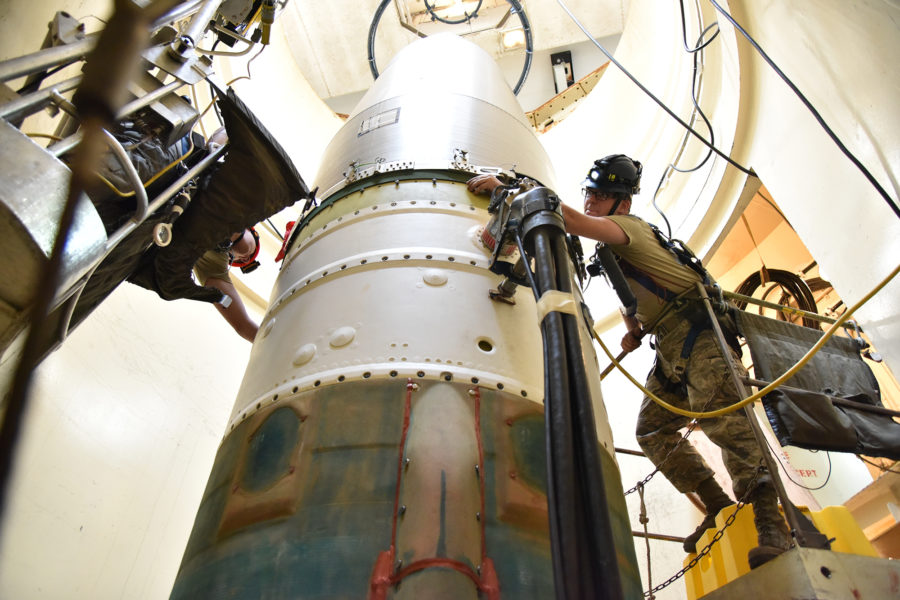The Air Force will take steps to ensure its Minuteman III intercontinental ballistic missiles can keep operating while the new Sentinel ICBM is delayed—but the moves won’t constitute a service life extension program, Deputy Chief of Staff for Strategic Deterrence and Nuclear Integration Lt. Gen. Andrew J. Gebara said July 15.
Minuteman III has had multiple service life extensions throughout its long history, turning what was originally meant to be a 10-year program into a 50-plus-year mainstay of U.S. nuclear deterrence. The most recent, which wrapped up in 2015, was meant to keep the missile operational through 2030.
Sentinel had been scheduled to reach initial operational capability by September 2030, but the Pentagon and the Air Force announced last week that the program will be delayed at least three years, as cost overruns sparked a program restructuring.
Now, at least some Minuteman missiles will likely to have keep going until the end of the 2030s, as the Air Force plans a phased approach swapping in Sentinel for Minutemen over the course of several years. Full operational capability for Sentinel had been set for 2036, before the latest delays were announced.
Officials have repeatedly said Minuteman III is nearing the end of its service life due to its age and parts obsolescence, and Gebara warned during a Mitchell Institute for Aerospace Studies event that still more issues could come up.
“Minuteman is going to have to continue. I can show you charts and budget lines and the like that gets after every one of the challenges we see in Minuteman to keep it relevant,” he said. “But we can only program and plan to what we know is going on, and what we can predict is going on. And as we go to the right, whether it be Minuteman … whether it be whatever have you, there’s always the chance of an unknown unknown.”
With certain parts no longer being manufactured, the Air Force will need long lead times for procuring some of them, and retired Air Force Col. Jennifer Reeves, a senior resident fellow at the Mitchell Institute and former ICBM wing commander, noted to Air & Space Forces Magazine that projecting future maintenance needs for the missiles is a relatively new, still unfolding effort.
“We didn’t think things were going to be around this long, such that we would have to do forecasting of when components and whatnot were actually going to fail,” she said.
Congress, the Pentagon, and the Department of the Air Force are all ready to spend to keeping Minuteman viable, Gebara said.
“Our Air Force is absolutely committed to making sure Minuteman is sustained,” Gebara said. “We have good funding for that now. We will continue and have pledged to continue with Congress if unknown unknowns happen on Minuteman, we will get after that and make sure that that’s covered until such time as Sentinel stands alert.”
Despite that, Gebara dismissed the idea that the work on Minuteman would be a full-fledged service life extension, or SLEP.
“A SLEP was one of the considerations [Pentagon acquisitions boss William LaPlante] looked at to see if that made sense, and a long-term SLEP still does not make sense for Minuteman,” Gebara said. “What is going to happen is Minuteman sustainment to keep it viable until Sentinel is delivered.”
The Air Force also considered a SLEP to Minuteman when it was first working on Sentinel, during an analysis of alternatives in 2014.
Permanent modifications, like a SLEP, to fielded programs are regulated by a formal process under Air Force policy—for changes that cost $100 million or more, Headquarters Air Force must approve a form submission.
Instead, Reeves suggested, Gebara’s comments indicate the Air Force is “going to be listening to what the missiles are telling them,” she said. “When problems happen, they’ll deal with the problems as opposed to a sweeping program that goes through and fixes x, y, and z components of all of the weapons to make them last longer, extend that life from an official perspective.”
Indeed, the Air Force regularly spends tens of millions of dollars each year on modifications to Minuteman and has initiated SLEPs for subcomponents without declaring one for the whole missile.
A formal SLEP would also likely raise questions from critics of Sentinel, but both Gebara and Reeves argued the need for Sentinel remains unchanged. Reeves compared keeping Minuteman going to maintaining an old car—technically possible, but expensive and ultimately a short-term solution.
As the costs to Sentinel rise, Gebara argued the Air Force is upping its oversight of the program to ensure it stays on track, from appointing a new ICBM Modernization Site Activation Task Force czar to replacing the program executive officer to its plans for establishing a new Nuclear Systems Center.
“You have the operational commander as a two-star guy focusing on beddown in the program. You have a PEO that’s a two star,” Gebara said. “You have a three-star lead policy here. And then you have a three-star nuclear materiel manager at the Nuclear Systems Center. So I think that’s a very broad growth in that oversight and leadership, and really what that translates to is experience, it’s not just about stars. It’s about how much those acquisition leaders have experienced in the past, and so I have high confidence that they’ll be able to get after [that].”
